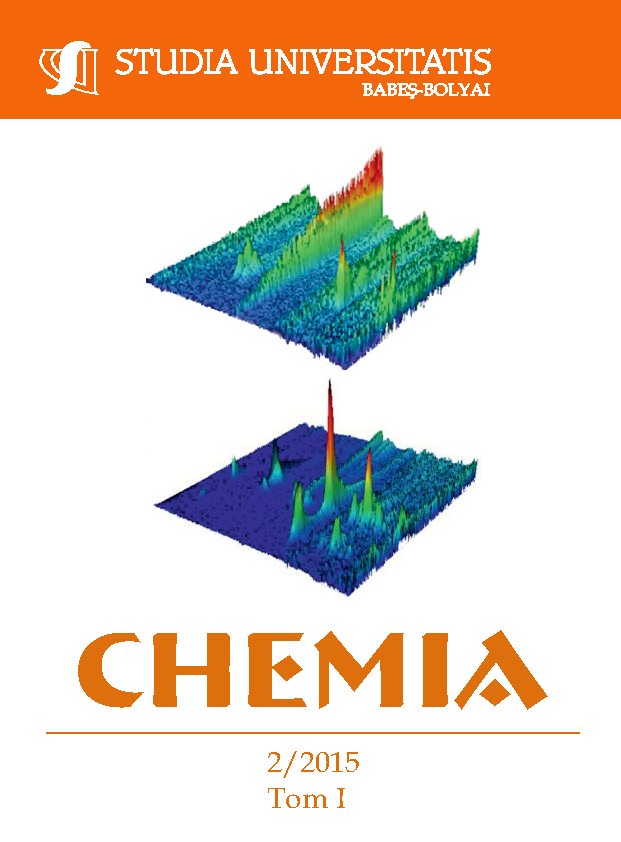IMMUNOMODULATORY POTENTIAL OF PALLADIUM(II) COMPLEXES WITH (1E,6E)-1,7-BIS (3,4-DIMETHOXYPHENYL) HEPTA-1,6-DIENE-3,5-DIONE
Keywords:
(1E,6E)-1,7-bis(3,4-dimethoxyphenyl)hepta-1,6-diene-3,5-dione, palladium complex, cancer therapy, immune responseAbstract
In chemotherapy, the metal-based cytotoxic drugs are invariable components of therapeutic protocols, despite the biologic drugs expansion. A current tendency is to design metal-based drugs with highest efficacy and limited toxicity on normal human cells implicated in immune response. Therefore we synthesized and characterized two palladium(II) complexes with (1E,6E)-1,7-bis(3,4-dimethoxypenyl)hepta-1,6-diene-3,5-dione, a curcuminoid like ligand; their cytotoxicity towards tumor cells was tested, and their expected impact on T and B lymphocytes was measured in vitro. The lymphocytes treatment with the free ligand, and with the two complexes 1 and 2, increased significantly the proportion of the T helper CD4 positive cell population, concomitant with the decrease of T effector CD8 positive cells. The B cells were not affected by 1, but 2 has a minor inhibitory effect on CD19+ and CD45RA+ cells. The cells function was tested through the compounds modulator effect on membrane markers CD25 and GITR, both being slightly down regulated by 2, compensating of CD4+ overexpression and CD8+ down regulation. Moreover, complex 1 displayed minimal interference with the cellular antitumor immunity, acting as a selective inhibitor of cancer cells growth.
References
S. Dasari, P.B. Tchounwou, European Journal of Pharmacology, 2014, 740, 364.
N. Hashima, B.B. Aggarwal, International Journal of Biochemistry and Molecular Biology, 2012, 3, 328.
S.C. Gupta, S. Prasad, J.H. Kim, S. Patchva, L.J. Webb, I.K. Priyadarsini, B.B. Aggarwal, Natural Products Report, 2011, 28,1937-55.
Z.C. Ding, G. Zhou, Clinical and Developmental Immunology, 2012, 2012, 890178.
A. Valentini, F. Conforti, A. Crispini, A. De Martino, R. Condello, C. Stellitano, G. Rotilio, M. Ghedini, G. Federici, S. Bernardini, D. Pucci, Journal of Medicinal Chemistry, 2009, 52, 484.
L. Baum, A. Ng, Journal of Alzheimer’s Disease, 2004, 6, 367.
N. Miklášová, R. Mikláš, F. Devínsky, Palladium complexes of curcumin and its analogues and methods of preparation of the same, Patent WO 2014/175841 A1, 2014.
N. Miklášová, E. Fischer-Fodor, R. Mikláš, L. Kucková, J. Kožíšek, T. Liptaj, O. Soritau, J. Valentová, F. Devínsky, Inorganic Chemistry Communications, 2014, 46, 229.
G. Karp. Cell and Molecular Biology- Concepts and Experiments, John Wiley & Sons, Hoboken, USA, ISBN-13 978-0-470-48337-4, 6th Ed, 2010, Chapter 17.
V.C. Liu, L.Y. Wong, T. Jang, A.H. Shah, I. Park, X. Yang, Q. Zhang, S. Lonning, B.A. Teicher, C. Lee, Journal of Immunology, 2007, 178, 2883.
P.J. Roughley, D.A. Whiting, Journal of the Chemical. Society Perkin Transactions 1, 1973, 2379.
A. Kessel, T. Haj, R. Peri, A. Snir, D. Melamed, E. Sabo, E. Toubi, Autoimmunity Reviews, 2012, 11, 670.
J.A. Ledbetter, N.K. Tonks, E.H. Fischer, E.A. Clark, Proceedings of the National Academy of Sciences of the USA, 1988, 85, 8628.
G. Nocentini, C. Riccardi, European Journal of Immunology, 2005, 35, 1016.
C. Morimoto, T. Takeuchi, S.F. Schlossman, Clinical and Experimental Rheumatolology, 1989, 7, S3.
T. Ramirez-Montagut, A. Chow, D. Hirschhorn-Cymerman, T.H. Terwey, A.A. Kochman, S. Lu, R.C. Miles, S. Sakaguchi, A.N. Houghton, M.R. van den Brink, Journal of Immunology, 2006, 76, 6434.
A.L. Côté, P. Zhang, J.A. O'Sullivan, V.L. Jacobs, C.R. Clemis, S. Sakaguchi, J.A. Guevara-Patiño, M.J. Turk, Journal of Immunology, 2011, 186, 275.
E. Fischer-Fodor, A.M. Vălean, P. Virag, P. Ilea, C. Tatomir, F. Imre-Lucaci, M. Perde Schrepler, L.T. Krausz, L.B. Tudoran, C.G. Precup, I. Lupan, E. Hey-Hawkins, L. Silaghi-Dumitrescu, Metallomics, 2014, 6, 833.
J. Ceballos-Torres, P. Virag, M. Cenariu, S. Prashar, M. Fajardo, E. Fischer-Fodor, S. Gómez-Ruiz. Chemistry - A European Journal, 2014, 18, 10811.
Downloads
Published
How to Cite
Issue
Section
License
Copyright (c) 2015 Studia Universitatis Babeș-Bolyai Chemia

This work is licensed under a Creative Commons Attribution-NonCommercial-NoDerivatives 4.0 International License.



